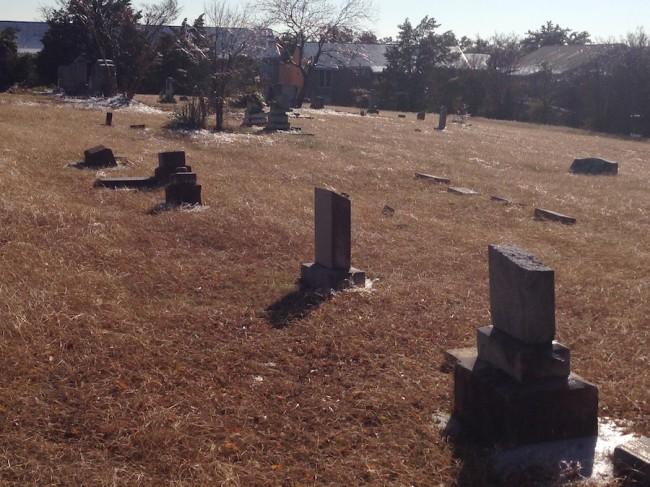
Tucked away behind the homes on Queenswood and Estate lanes in Lake Highlands there is a small three-acre tract of land covered in history.
Sandwiched between a row of houses and an apartment complex, McCree Cemetery is located just east of the AT&T; building on Audelia Road making it very hard to see.
The cemetery houses the tombstones of some of the area’s early settlers dating back to the 19th century. But a step inside the cemetery reveals that the historic site has fallen into disrepair, with vandalized and cracked tombstones, overgrown weeds and brush jutting through the fallen markers, and trash scattered throughout the grounds.
That’s why Preservation Dallas is stepping in to restore the historic site. Preservation Dallas is a nonprofit membership organization dedicated to preserving, protecting and revitalizing Dallas’ historic buildings, neighborhoods and places.
“This kind of project is new to us, we deal mainly with buildings,” said Preservation Dallas Executive Director David Preziosi.
Although outside of their comfort zone, Preziosi and his team felt it was an important project to enhance the history and community of Lake Highlands. The group agreed to the project after being approached by a local realtor.
With the help of a group of professionals specializing in cemeteries and a $200,000 grant received in September from B.B Owen Trust, a nonprofit organization, Preservation Dallas and its team immediately started examining the gravesite and raising awareness.
The project and restoration is still in its very early stages, but Preziosi is hopeful it will be completed by next summer.

PHASE ONE
There are several steps to restoring a historic land site and preserving its content. Victoria Clow, a preservation consultant and project manager for the McCree Cemetery project, said it will be several months before changes to the site will be apparent.
“It is tempting to just rush in and start working, but historic cemeteries need to be treated like an archaeological site,” said Clow.
Before actual restoration can begin, the first step is to examine the conditions of the gravestone markers and the landscape. The first phase will also include establishing a “friends group,” said Preziosi.
Dallas Park Board member for District 10 and Lake Highlands native Robin Moss Norcross is planning to raise awareness and share the history of the cemetery with residents and the community during the course of the project.
Through “Friends of McCree”, neighbors and family members can support the efforts of the restoration project by helping create a better written record of who the area’s early settlers were and what their lives were like. Norcross will serve as a point of contact for people inquiring about the cemetery, and will eventually become responsible for an endowment to sustain the cemetery’s upkeep.
“There is a tremendous amount of history there, and we want people with ancestors in the cemetery to share their stories,” said Norcross.
Lake Highlands resident Kim Marion, for instance, contacted Norcross with information regarding one of the cemetery’s residents: her ancestor Monty.
In examining the cemetery, the project’s team must also investigate unmarked graves.
“In many historic cemeteries you’ll see homemade markers with cement pieces or wood, and sometimes there are no markers at all,” said Clow.
Previous records suggest the number of burials in the cemetery to be more than 250. Through additional research and examination by professionals specializing in historic landscapes, the total number of people buried in the 3-acre site will be determined.

THE HISTORY OF MCCREE
The origins of the cemetery date back to 1866 when Mahulda Bonner McCree was granted the land. Mahulda McCree deeded one and a half acres of land, and members of the Griffin family deeded a little over half an acre in 1896. The first burials on site actually happened before the graveyard was formally deeded when John Henry Jones was buried there in 1862 as well as Elizabeth McCullough in 1864.
Over the years the cemetery has been enlarged to cover over three acres. A small church was built at the cemetery and was used by different groups for revivals and burials. The Rodgers Baptist Church congregation used the cemetery grounds and buildings in the 1930s after a fire had destroyed their own congregation’s building. Because of this, the cemetery is sometimes mistakenly called the Rodgers, or Rogers Cemetery, but it is officially the McCree Cemetery named for Mahulda McCree its founder.
The cemetery contains the graves of many of the early founders of Little Egypt, a local community founded by freed slaves following the Civil War, war veterans and other people associated with the early area Methodist and Baptist churches. Many residents might be unaware of the history found right in their backyards, while some might recognize the names of some of the early settlers, including the Goforths, who have a street named after them in the area. The cemetery also houses a state historical marker, installed and dedicated on April 6, 1986.
CONTINUING EDUCATION
A big component in preserving the McCree Cemetery is to continue education and awareness after the project has been restored. Preservation Dallas wants to preserve the importance of the cemetery by educating and sharing the history with the community and neighborhood, said Preziosi.
“We plan to host ‘How-To’ workshops on Texas cemetery preservation,” he said.
Neighbors and community members have shown a tremendous amount of positive feedback in wanting to volunteer with efforts in preserving the area’s history, said Norcross.
“People have been coming out of the woodwork wanting to help and provide information,” she said.
If you are interested in volunteering or have any information regarding the history of the cemetery, call Preservation Dallas at 214-821-3290.
Alexa Malevitis is an SMU journalism and fashion media major with a minor in advertising. She can be reached at amalevitis@smu.edu.








